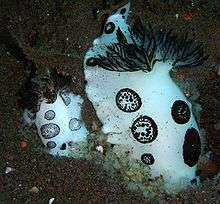Jorunna funebris
Jorunna funebris, commonly called the dotted nudibranch, is a large species of sea slug. It is a dorid nudibranch, meaning it is a shell-less marine gastropod mollusc in the family Discodorididae.[2] The genus Jorunna is composed of roughly 15 other species of nudibranchs, which feed on a variety of sponges.[3]
| Jorunna funebris | |
|---|---|
 | |
| Scientific classification | |
| Kingdom: | |
| Phylum: | |
| Class: | |
| (unranked): | clade Heterobranchia clade Euthyneura clade Nudipleura clade Nudibranchia clade Euctenidiacea clade Doridacea |
| Superfamily: | |
| Family: | |
| Genus: | |
| Species: | J. funebris |
| Binomial name | |
| Jorunna funebris | |
| Synonyms[2] | |
| |
Distribution
This species was described from Sri Lanka. It is widespread in the Indo-Pacific region from the Red Sea and the Indian Ocean along the East African coast to Australia and New Caledonia.[4][5] Jorunna funebris preys exclusively on sponge in the genus Xestospongia, and as such, the sea slug's distribution aligns closely with the distribution of Xestospongia.[6]
Chemistry of Jorunna funebris
This species contains a chemical compound called "jorumycin," which shares the same tetrahydroisoquinoline[7] backbone as an anti-tumor drug called Zalypsis, or PM00104.[8] In addition, another compound called jorunnamycin A,[9] has been found alongside fennebricins A (1) and B (5), both of which are bis-tetrahydroisoquinolinequinones and related to two classes of anti-tumor alkaloids.[10]
References
- Kelaart, Edward Frederick. 1858. Descriptions of new and little known species of Ceylon nudibranchiate molluscs and zoophytes. Journal of the Royal Asiatic Society Ceylon Branch, Colombo 3(1):84-139, 2 pls.
- Bouchet, P. (2010). Jorunna funebris (Kelaart, 1859). Accessed through: World Register of Marine Species on 2011-08-24
- Y.E. Camacho-Garcia, T.M. Gosliner Systematic revision of Jorunna Bergh, 1876 (Nudibranchia: Discodorididae) with a morphological phylogenetic analysis J Molluscan Stud, 74 (2008), pp. 143-181
- Rudman, W.B., 1998 (December 31) Jorunna funebris (Kelaart, 1858). [In] Sea Slug Forum. Australian Museum, Sydney.
- Dayrat B. 2010. A monographic revision of discodorid sea slugs (Gastropoda, Opisthobranchia, Nudibranchia, Doridina). Archived 2015-09-08 at the Wayback Machine Proceedings of the California Academy of Sciences, Series 4, vol. 61, suppl. I, 1-403, 382 figs.
- Kasamesiri, Pattira, et al. "Observations on embryonic development of black-spot Jorunna, Jorunna funebris (Kelaart, 1859) (Gastropoda: Nudibranchia)." Journal of Shellfish Research, vol. 31, no. 1, 2012, p. 111+. Gale Academic OneFile.
- "jorumycin - MeSH - NCBI". www.ncbi.nlm.nih.gov. Retrieved 2020-06-30.
- Blunt, John W.; Copp, Brent R.; Munro, Murray H. G.; Northcote, Peter T.; Prinsep, Michèle R. (2011). "Marine Natural Products". Natural Product Reports. 28: 196–268 – via The Royal Society of Chemistry.
- "Synthetic Chemistry Takes Anti-Cancer Compounds out of the Sea Slug and into the Lab". California Institute of Technology. Retrieved 2020-06-30.
- He, Wen-Fei; Li, Yan; Feng, Mei-Tang; Gavagnin, Margherita; Mollo, Ernesto; Mao, Shui-Chun; Guo, Yue-Wei (2014-07-01). "New isoquinolinequinone alkaloids from the South China Sea nudibranch Jorunna funebris and its possible sponge-prey Xestospongia sp". Fitoterapia. 96: 109–114. doi:10.1016/j.fitote.2014.04.011. ISSN 0367-326X.
Further reading
- Vine, P. (1986). Red Sea Invertebrates. Immel Publishing, London. 224 pp
- Branch, G.M. et al. (2002). Two Oceans. 5th impression. David Philip, Cape Town & Johannesburg.
- Camacho-García, Yolanda E.; Gosliner, Terrence M. (2008). "Systematic revision of Jorunna Bergh, 1876 (Nudibranchia: Discodorididae) with a morphological phylogenetic analysis". Journal of Molluscan Studies. 74 (2): 143–81. doi:10.1093/mollus/eyn002.
External links
- Photos of Jorunna funebris on Sealife Collection